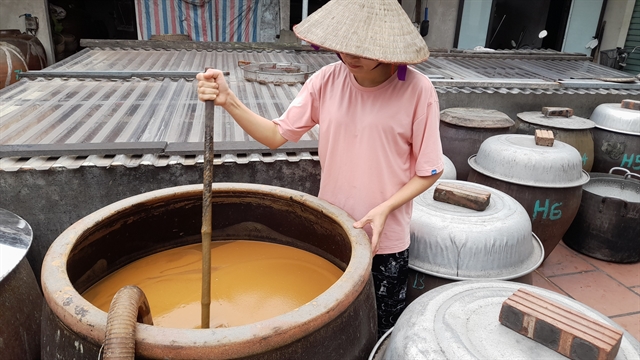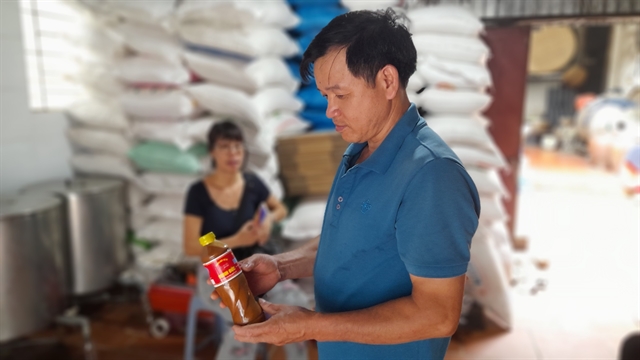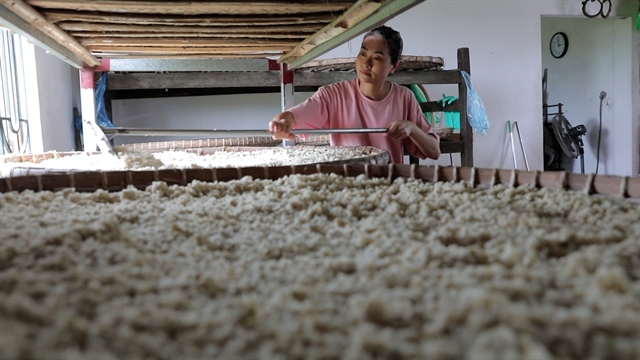Cự Đà craft village produces special soy sauce that possesses a naturally sweet flavour, which necessitates a series of intricate and meticulous steps to achieve the final product.

BIG BATCH: The soy sauce must have a bright yellow colour, with a sweet taste and rich aroma. — VNS Photo Thanh Nga
By Thanh Nga
(additional reporting by Lyly Cao and Kiều Trinh)
Cự Đà, an ancient village located in suburban Thanh Oai District of Hà Nội, embodies many characteristics of the northern countryside. The village is best known for its traditional glass noodles and soy sauce.
According to village elders, the craft of making soy sauce predates the craft of producing glass noodles, although the exact origins remain unknown.
What is known, however, is that the tradition of soy sauce making in Cự Đà dates back as far as the village itself, which is approximately 500 years old. Over generations, the ancestral craft of soy sauce making has become a much-cherished heritage of the village.
Đinh Công Minh, the proprietor of the Minh Đức soy sauce workshop in the village, proudly shared that he had been engaged in this profession for about 40 years. The trade was passed down to him by his forefathers, and is an integral part of his identity.
"The distinctive qualities that set Cự Đà soy sauce apart are its aroma, sweetness, potency, and balanced saltiness, devoid of any sourness or spiciness," Minh told Việt Nam News.

FEELING SAUCY: Đinh Công Minh, the proprietor of the Minh Đức soy sauce workshop, shows his product. — VNS Photo Thanh Nga
Cự Đà soy sauce possesses a naturally sweet flavour, which necessitates a series of intricate and meticulous steps to achieve the final product.
The production of this soy sauce relies on two primary ingredients: sticky rice and soybeans. The rice used is a special variety of high-quality sticky rice, which boasts a unique flavour and is predominantly grown in the northern delta and midland provinces. Similarly, the soybeans must be small, firm, plump, and have a light yellow hue.
The process of soy sauce making consists of two main stages: First culturing yeasts (or koji) by fermenting cooked glutinous rice for several days in a controlled environment. After approximately five or six days, the resulting yeasty rice, resembling a soft green-lentil cake, is transferred to a salt water tank.
The second stage involves having roasted soybeans ground, and then boiled for an hour. Once cooled, the mixture is poured into basins and later transferred to jars.
The mixture is left to steep for a period of 30 to 40 days. After this fermentation period, it is mixed with the yeast to make soy sauce.
Minh emphasised the equal importance of both the yeast culture and bean fermentation stages. If either of these stages fails to meet the required standards, the final product will not meet the desired quality.
He further explained that the entire process is carried out by hand, without the use of any additives. This meticulous approach ensures that Cự Đà soy sauce retains its distinctive sweetness and fragrance, setting it apart from products made in other craft villages.
The period from April to August is considered the optimal time for soya sauce production due to favourable weather conditions. Abundant sunshine helps in the fermentation process, yielding a unique flavour to the beans.
Cự Đà soy sauce is commonly used as a dipping sauce for various dishes such as boiled morning glory, salted aubergine, and half-done beef. It is also used in the preparation of braised fish.

FULL OF STICKY RICE: Lương Thị Thủy cultures yeasts on boiled sticky rice to make soy sauce. — VNS Photo Lyly Cao
During our visit to Cự Đà craft village, we made sure to visit the family of Đinh Công Thể, the production base of Trọng Tình soy sauce. His house is filled with hundreds of soy sauce jars, carefully prepared for customers.
Thể said that "Trọng" and "Tình" are the names of his father and grandfather, respectively. He chose to use this name as a brand to honour and promote his family's traditional craft.
"Since 2015, our product has been registered as an exclusive trademark," Thể said proudly.
The creation of the flavourful brand of soy sauce is the result of the careful work of Thể's wife, Lương Thị Thủy. Although the tasks are not overly burdensome, they require patience and attention to detail.

A FEW JARS: Lương Thị Thủy's house is filled with soy sauce jars, meticulously prepared for her customers. — VNS Photo Lyly Cao
Despite their hard work, soy sauce producers in Cự Đà face low incomes, which discourages others from pursuing the craft. Currently, the entire village has only five households engaged in soy sauce production.
According to Đinh Công Minh from the Cự Đà Craft Village Association, although there are only five households producing soy sauce, the level of production is higher than in the past.
Previously, villagers made soy sauce primarily for household consumption, with very little sold. Even though there were only five production households now, they could produce up to 1,000 litres per day, depending on demand.
"The risk of craft villages disappearing is also a concern. First, with the advancement of technology and science, young people in the village tend to choose less labour-intensive work. Second, consumer preferences have changed, and people are using soy sauce less," Minh said.
Despite the challenges, the Cự Đà villagers, such as Minh, Thể, and Thủy, remain dedicated to preserving the traditional craft. They strive to create the delicious taste and distinct aroma of Cự Đà soy sauce, contributing to the richness and distinguished history of Hà Nội's cuisine. VNS